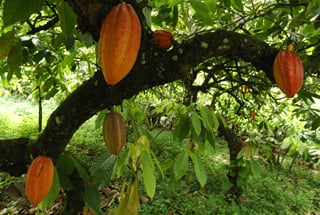Light-crop cocoa harvest in Nigeria, the fourth-biggest producer of the chocolate ingredient, may rise by as much as 20 per cent due to a rainfall pattern and chemicals that enhanced fruiting by trees, farmers have said.
Harvesting under the smaller of Nigeria’s two cocoa seasons started in March, a month earlier than normal, and may last up to May or June, boosted by rains that began last December and have continued in the cocoa-producing areas, the farmers explained.
“The rains have been stable – not too much and not scarce,” Robo Adhuze, spokesman for the Cocoa Association of Nigeria, said on April 24, from a farm at Idanre, near Akure, capital of western Ondo state, the biggest cocoa producer in the country.
Farmers in Itumbuzor in southeastern Abia state say rainfall has raised the quality of cocoa in a season usually characterised by smaller and lighter cocoa beans with lower butter content.
Advertisement
“The beans are still heavy. We are impressed with what we are seeing,” Isaiah Ise Ndiyo, a farmer said by phone from there.
The beans reduce in size and weight as the harvest thins out. Farmers in Ikom, Cross River state, expect increased harvests from May, Godwin Uku, one of them, said by phone.
“The weather there has been favourable,” he said.
Advertisement
Nigeria’s cocoa year is made up of two harvests. The main-crop season, which begins in October and ends in January officially, accounts for about two-thirds of the total annual output.
Sometimes, this may stretch into mid-March, especially when harvesting starts late due to delayed fruiting. The light-crop season usually begins in April and ends in June. The period between June and the commencement of the main-crop harvest serves for preparation of the farm, budding and maturity of the pods.
Nigeria is the world’s fourth-biggest cocoa producer after Ivory Coast, Ghana and Indonesia in cocoa production, according to figures published by the London-based International Cocoa Organization. Nigeria’s output accounts for about five per cent of the total world supply. Cocoa is Nigeria’s second-biggest foreign exchange earner, after earnings from crude oil, according to figures published by the Nigerian government.
Application of chemicals including, fertilizers and new cocoa varieties supplied by the government, also contributed to the rising yield, the farmers said. Government in 2011 introduced eight new varieties that start fruiting in as early as two years, with more than 200 per cent higher yield over older varieties.
Advertisement
“The chemicals helped farmers to refresh the trees and that has really boosted the light-crop harvest,” Ndiyo said.
Nigeria, Africa’s biggest economy following a GDP rebasing announced earlier this month, has set a target to produce 500,000 metric tons of cocoa per year from 2015, under the Cocoa Transformation Agenda. Last year, the country produced about 270,000 metric tons, while production in the 2013/14 crop year could rise to between 300,000 metric tons and 310,000 metric tons, according to Adhuze.
Add a comment






